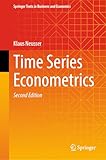Time series econometrics
Material type: TextSeries: Springer Text in Business and EconomicsPublication details: Switzerland Springer 2025Edition: 2ndDescription: xvii, 429pISBN:
TextSeries: Springer Text in Business and EconomicsPublication details: Switzerland Springer 2025Edition: 2ndDescription: xvii, 429pISBN: - 9783031888373
- 330.015195 NES
| Item type | Current library | Collection | Call number | Copy number | Status | Date due | Barcode | |
|---|---|---|---|---|---|---|---|---|
 Book
Book
|
Indian Institute of Management LRC General Stacks | Public Policy & General Management | 330.015195 NES (Browse shelf(Opens below)) | 1 | Available | 009158 |
Front Matter
Pages i-xxiii
Download chapter PDF
Univariate Time Series Analysis
Front Matter
Pages 1-1
Download chapter PDF
Introduction and Basic Theoretical Concepts
Klaus Neusser
Pages 3-22
Autoregressive Moving-Average Processes
Klaus Neusser
Pages 23-42
Forecasting Stationary Processes
Klaus Neusser
Pages 43-65
Estimation of the Expected Value and the Autocorrelation Function of a Stationary Stochastic Processes
Klaus Neusser
Pages 67-86
Modeling Stationary ARMA Processes
Klaus Neusser
Pages 87-106
Spectral Analysis and Linear Filters
Klaus Neusser
Pages 107-132
Integrated Processes
Klaus Neusser
Pages 133-169
Models of Volatility
Klaus Neusser
Pages 171-195
Multivariate Time Series Analysis
Front Matter
Pages 197-197
Download chapter PDF
Synopsis on Empirical Macroeconomic Research
Klaus Neusser
Pages 199-201
Definitions and Stationarity
Klaus Neusser
Pages 203-208
Estimation of Mean and Covariance Function
Klaus Neusser
Pages 209-217
Vector Autoregressive Moving-Average Processes
Klaus Neusser
Pages 219-229
Estimation of Vector Autoregressive Models
Klaus Neusser
Pages 231-247
This text presents modern developments in time series analysis and focuses on their application to economic problems. The book first introduces the fundamental concept of a stationary time series and its relation to the basic properties of covariance funtions, investigating the structure and estimation of autoregressive-moving average (ARMA) models and their relations to the covariance structure. The book then moves on to non-stationary time series, highlighting its consequences for modeling and forecasting as well as regressions models and presenting standard statistical tests. Next, the text discusses volatility models and their applications in the analysis of financial market data, focusing on generalized autoregressive conditional heteroskedastic (GARCH) models. The second part of the text is devoted to multivariate processes, such as vector autoregressive (VAR) models and structural vector autoregressive (SVAR) models, which have become the main tools in empirical macroeconomics. The text concludes with a discussion of co-integrated models and the Kalman Filter, which is being used with increasing frequency. The exposition finally connects to recent developments in the field. Mathematically rigorous, yet application-oriented, this self-contained text will help students develop a deeper understanding of theory and better command of the models that are vital to the field. Assuming a basic knowledge of statistics and/or econometrics, this text is best suited for advanced undergraduate and beginning graduate students. (https://link.springer.com/book/10.1007/978-3-031-88838-0)
There are no comments on this title.

